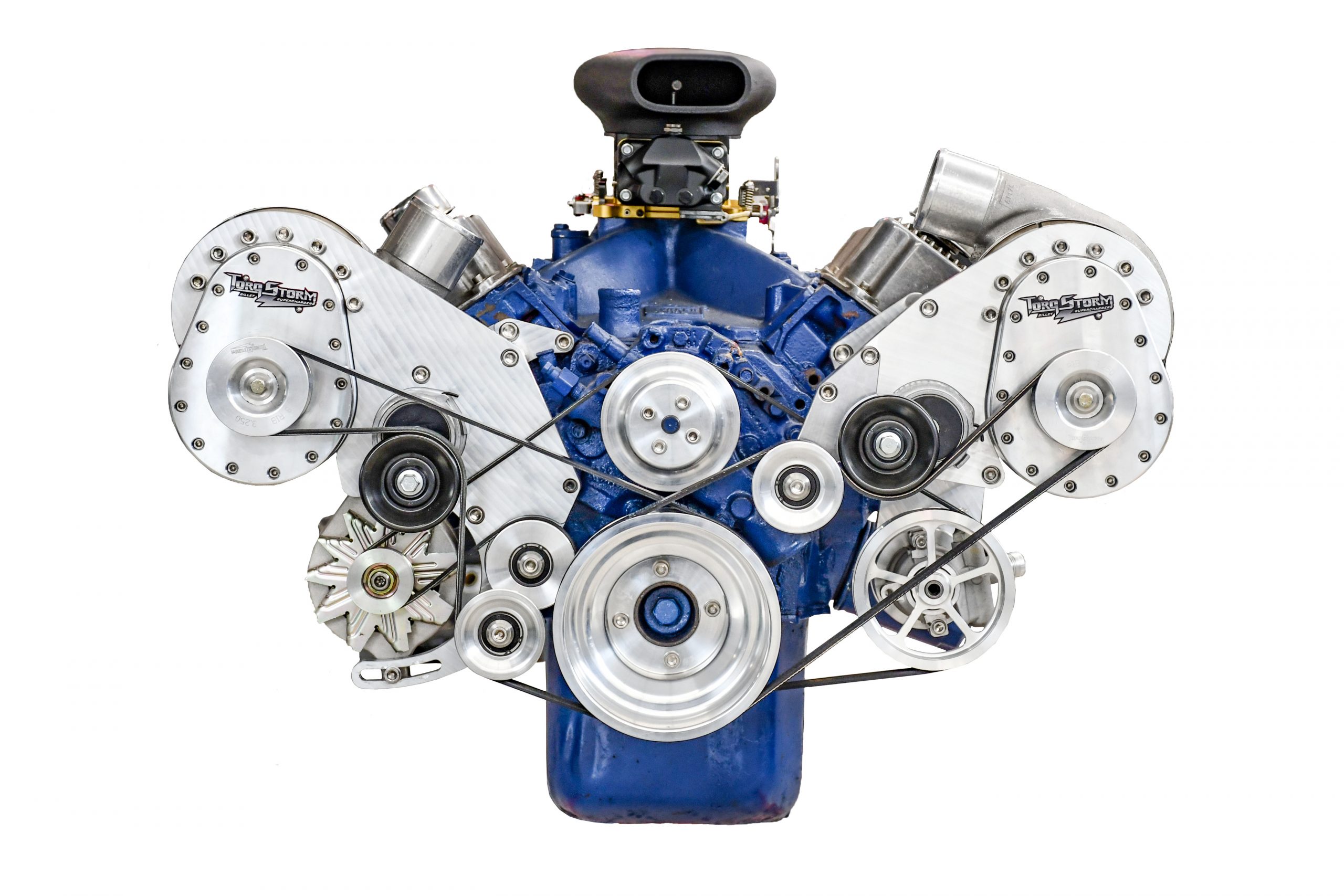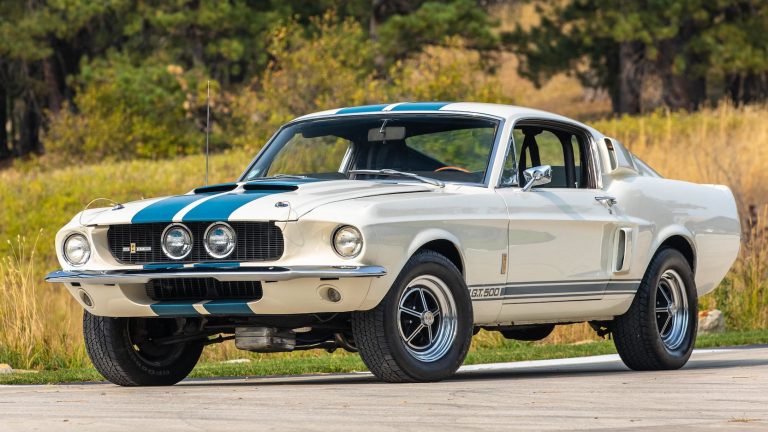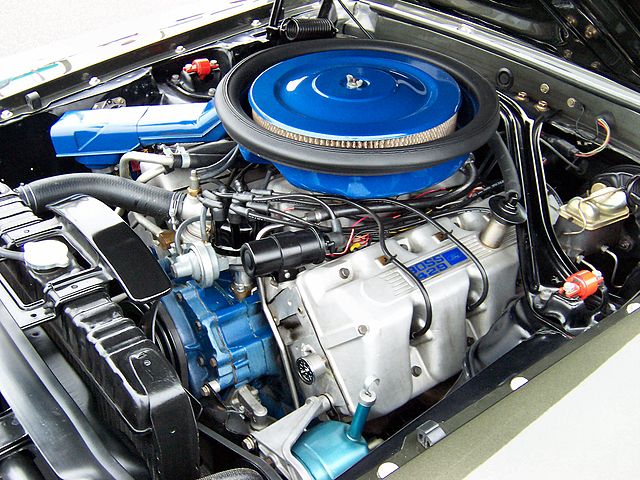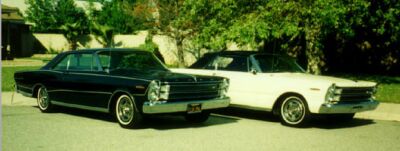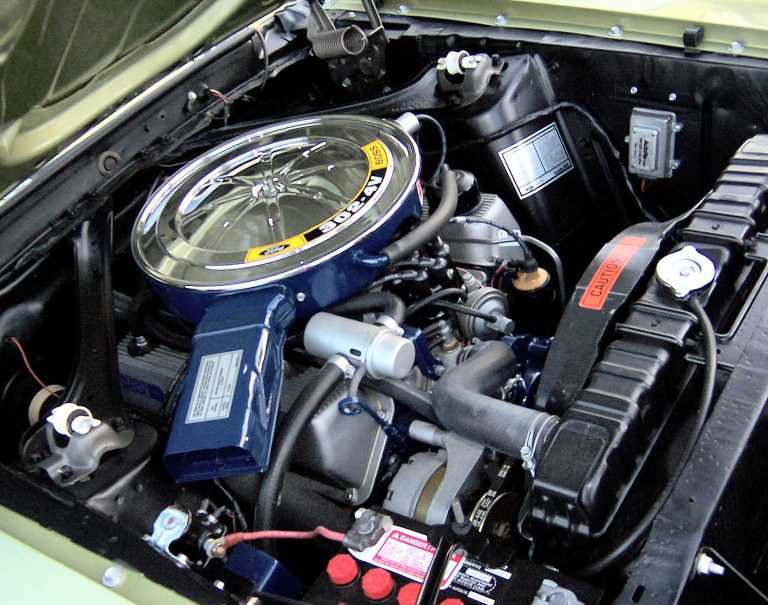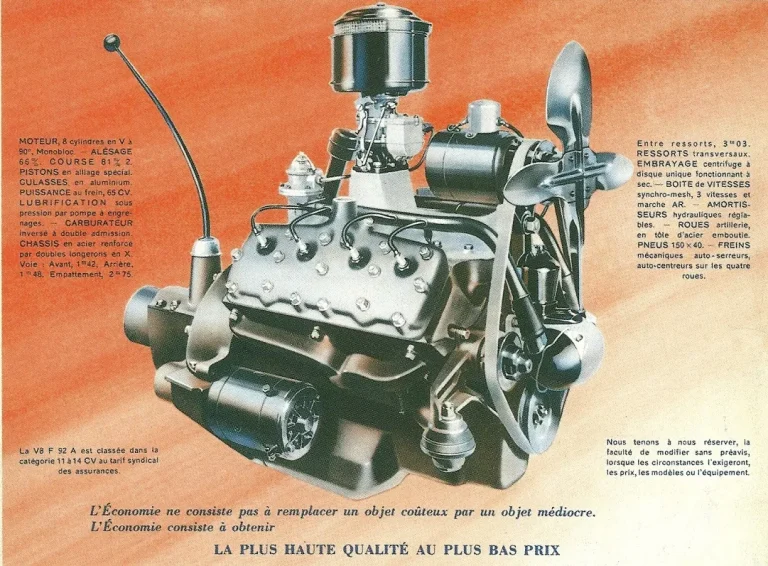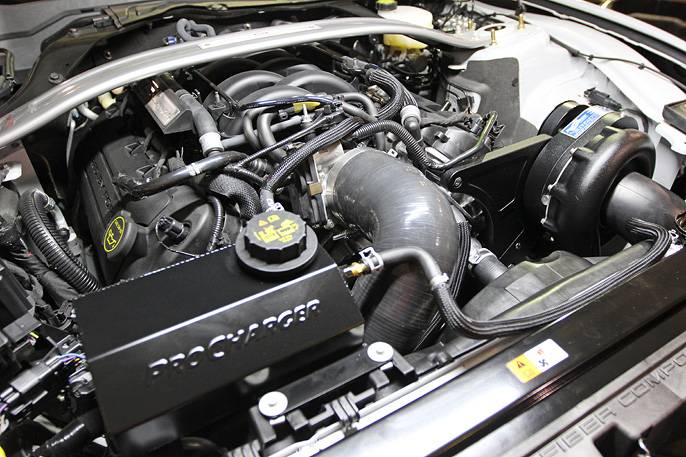Ford 351 Cleveland Engine Guide

Meet Austin
Austin has been a muscle car enthusiast since an early age with his Dad having a collection including a 1965 Mustang, 1968 Mercury Cougar, and a 1969 Mustang Mach 1 among many others. Austin received a technical writing degree from University of Colorado Denver with the intentions of becoming an automotive journalist. His automotive knowledge, enthusiasm, and hands on experience allow him to craft detailed, accurate, and high-quality articles for the passionate Muscle Car Club audience.
The Ford small block catalog is both extensive and legendary. Ford FE, Windsor, and 335 engine series are all giants of the American V8 lore, and all played a significant part in establishing the United States as a force to be reckoned with when it comes to engine development. The Ford 335 engine family is an interesting one as it existed outside of the Windsor V8 family, yet ran concurrently with it as well. One of the most famous engines in the Ford 335 engine family is the 351 Cleveland. The 351 Cleveland adds even more complexity into the mix, as it shared almost no interchangeable parts with the Windsor V8 family despite sharing an identical displacement with the 351 Windsor.
The 351 Cleveland is an engine cherished for its performance-focused design, strength, and overwhelming aftermarket support. Not to mention, the 351 Cleveland was used in some of the most iconic Ford and Mercury models in history including the Mustang Boss 351 and Mercury Cougar. The 351’s design reflected its performance applications, with impressively free-flowing heads, high compression ratios, and aggressive factory cams.
This guide will cover the entire Ford 351 gamut, including its history, specs, common problems, and performance upgrades.
Ford 351 Cleveland Engine History
While one of the most popular V8 engines in modern history, the Ford 251 Cleveland has an interesting, if not disjointed, and messy history. With the muscle car glitz and glamour slowly waning at the tail end of the 1960s, Ford seemed somewhat confused with their ultimate direction on that front. But, they had money to throw at the problem. By 1970, Ford had the small-block and big-block segments solidly covered. The 289 and 302 occupied one end and the 390 and 428 occupied the other. With that being said, Ford had middle-child cars that needed middle-child engines.
In terms of engine dimensions, Ford had pretty much maxed out the Windsor small block with the 302. As a result, Ford designed a 351 cid Windsor V8 to fill the gap between the Ford 302 and 390. The 351 Windsor, often called the 351W, was designed with previous Windsor engines in mind, like the 289 and 302. Despite the design inspiration, the 351W shares little with smaller Windsor engines. Anyway, we aren’t here to talk about the 351 Windsor.
In case you forgot, this article is about the 351 Cleveland, which would be released one year after the 351W. Compared to the 351 Windsor, the 351 Cleveland was a blank sheet design with no influence from the Windsor family. Bore spacing and stroke are their only similarities. While it might seem downright strange to release two 351 cid V8 engines with entirely different designs a single year apart, the engines were to serve different purposes. Ford designed the 351C to be the performance-oriented variant with freer flowing cylinder heads and large canted valves.
351 Cleveland Engine Specs
| Engine Code | Engine Type | Years | Compression Ratio |
| H | 351C-2V | 1970-1974 | 9.5:1 – 8.0:1 |
| M | 351C-4V | 1970-1971 | 11.0:1 – 10.7:1 |
| R | 351C-4V | 1971 | 11.1:1 |
| R | 351C-4V HO | 1972 | 9.2:1 |
| Q | 351C-4V CJ | 1971-1974 | 9.0:1 |
| Engine | Ford 351 Cleveland V8 |
| Configuration | 90-degree V8 |
| Displacement | 5.8L ( 351cid) |
| Aspiration | Naturally Aspirated |
| Valvetrain | Overhead Valve |
| Block/Head | Cast-Iron |
| Bore x Stroke | 4.0″ (102mm) x 3.5″ (98mm) |
| Compression Ratio | 9.0:1 – 11.1:1 |
| Weight | 260-330 lbs |
| Horsepower | 260 hp – 330 hp |
| Torque (lb-ft) | 355 lb-ft – 380 lb-ft |
Ford 351 Cleveland Engine Variants
In addition to the three different Ford 351 engine families, including the Ford 351 Windsor, 351 Cleveland, and 351 Modified/Michegan, there are also different 351 variants within each family. Way to make things confusing, Ford. In actuality, the 351C’s engine variants are pretty straightforward and differ primarily in compression ratio and carburetor configuration. Over the 351 Cleveland’s very short three-year production run, there were five distinct 351 Cleveland V8 variants that were used in different cars at different trim levels.
H-Code
While the 351 Cleveland V8 is a powerful engine regardless of the variant, the H-Code is at the bottom of the totem pole in terms of frills and party tricks. The H-Code 351C utilizes a 2-barrel carburetor. It also featured a low 9.5:1 compression ratio for the first part of its production, eventually dipping even lower to an 8.0:1 compression ratio for the final two years of production. The Ford H-Code also had the worst flow characteristics of all of the Ford 351 variants. It featured small port 2V heads and open combustion chambers. The 351C H-Code is also the most common example of the Cleveland, as it was placed in numerous Ford and Mercury pony and full-size cars.
M-Code
In comparison to the 351 H-Code, the 351 Cleveland M-Code is the high-performance variant of the standard 351 Cleveland. The M-Code 351 Cleveland was always meant to go into cars like the Ford Mustang, Mercury Cougar, Mercury Montego, and Ford Torino and received significant upgrades over the H-Code engines to increase performance. One of the most significant upgrades to the 351 M-Code is the inclusion of large 4V heads. That allowed the M-Code to breathe significantly better than the H-Code. The upgraded head paired with a Autolite 4300-A 4-barrel carburetor added a significant amount of grunt to the equation.
The M-Code also received a more aggressive hydraulic camshaft, stiffer valve springs, and cast aluminum flat-top pistons. Due to the flat-top pistons and other design differences between the H-Code and M-Code, the 351 Cleveland M-Code has a considerably higher compression ratio of 11.1:0. The high compression ratio required the M-Code to be run on only premium fuel.
Boss 351 R-Code
The 1971 351 Cleveland R-Code, more often called the 351 Boss engine, is a legend in the Ford community. Not only is the Boss 351 the most powerful variant of the Ford 351 cid V8, but it is also the strongest. Unlike other 351 variants, the 351 R-Code is a 4-bolt main engine with solid lifters. It also used a hardened cast iron crankshaft and forged connecting rods. The 351 Boss is chock full of lightweight parts that are unique to the Boss itself. The R-Code has a fully aluminum intake manifold and valve covers.
The additional power from the 351 Boss engine comes from multiple revisions to the M-Code 351. The R-Code uses forged domed aluminum pistons that increase the engine’s compression ratio to 11.1:1. The Boss 351 had better internal flow characteristics than other models as well due to a reworked cylinder head with larger combustion chambers. The R-Code Boss 351 is an exceedingly rare engine to come across in the wild. It is said that there were around 1,806 Boss 351 Mustangs in total. There are reportedly only 591 known examples that are still on the road. The R-Code is even rarer due to the fact that it was only offered for one year in 1971.
HO R-Code
The early 1970s were a bad time for performance V8 engines. The 1970 Clean Air Act made some extensive changes to emissions requirements. These affected most of the major American auto manufacturers who were producing big-horsepower muscle cars. That included Ford. The 1972 Ford 351 R-Code H.O. was a reflection of these restrictions. It was significantly less powerful than the 351 Boss that came the year prior. One of the most significant changes came in the form of flat-top pistons. The new pistons reduced the 351 R-Code’s compression ratio to 9.2:1. The heads were also changed to an open chamber style instead of the closed design used on the 1971 R-Code and M-Code 351 V8.
The 1972 R-Code also featured a redesigned camshaft with more valve lift but less duration. The valvetrain remained largely unchanged from the year before, with equally large ports and valves. While the 1971 R-Code 351 was only available in the Mustang Boss 351, the 1972 R-Code could be ordered in any trim level of the Mustang lineup.
Q-Code
By the time the Q-Code 351 Cleveland was released in 1971, Ford was focused far more on meeting emissions regulations than they were on performance. To be fair, that situation wasn’t unique to Ford. The Q-Code was the 351 Cleveland engine found in 1971-1974 Ford Mustangs, Rancheros, Torinos, Mercury Montegos, and Mercury Cougars. While the Q-Code wasn’t as powerful as the original Boss 351 R-Code, it did include some performance parts that made it almost as powerful as the 1971 R-Code.
The 351 Cleveland Q-Code is a low-compression example of the 351 Cleveland, similar to the year before. It also used 4V heads that were emissions-focused rather than performance focused. While the 351 Cobra Jet, often called the 351CJ, used a long duration 270° I/ 290° E 48° camshaft, and upgraded carburetor, the engine’s output peaked at 266 horsepower.
Best Ford 351 Cleveland Engine Upgrades
The Ford 351 Cleveland is a legendary engine with a lot of love and support in the muscle car community. Since the 351C was featured in so many legendary cars, from the Mercury Cougar to the Mustang Boss 351, power chasers were bound to fiddle with Ford’s largest displacement small block. When it comes to the most effective engine modifications for most classic Ford engines, there is a general recipe that has been tried and tested.
Ultimately, with the low compression and economy-focused 351 Cleveland variants, opening up airflow in the heads is one of the most common and important power-increasing modifications that you can do. With the 4V 351 Cleveland variants, head breathability wasn’t an issue at all thanks to the massive ports and valves. For the high-performance 351C variants, like the M-Code and Boss 351 R-Code engines, an upgraded carburetor and more aggressive cam would likely yield the best results. Here are our recommended Ford 351 Cleveland engine upgrades:
- 1971 R-Code Heads (or comparable aftermarket performance heads)
- Upgraded 351C Carburetor
- More aggressive 351C Cam
- 351C Long Tube Headers
High-Flow 351C Heads (1971 R-Code Heads)
If you already have a Boss 351 Cleveland, first of all, congratulations. Second, this modification does not apply to you, as the 351C R-Code heads are the best breathing heads available for the 351 Cleveland. Ultimately, the 351C heads with smaller quench combustion chambers increase the compression ratio, improving overall power.
That is significant with the low-compression 4V 351 Cleveland variants, including the 1972 R-Code 351C-4V, and Q-Code 351C-4V, as you’ll need more compression to make significant power without a blower. While you can technically swap the 4V heads onto a 2V block, you’d also need to swap out the upper/lower intake, injectors, rotating assembly, pistons, timing assembly, flywheel, and alternator, making it not really worth the extra hassle.
With that being said, there are numerous aftermarket high-flow 2V heads available for the 351C. Even aftermarket options will make a massive performance difference. The ultimate goal of upgrading your 351 Cleveland V8 heads is to improve both intake and exhaust flow, which all of the factory 2V Cleveland heads do rather poorly. TrickFlow PowerPort 225cc ported heads are a good option to improve cylinder head flow on 2V 351 Cleveland V8s.
Upgraded 351 Cleveland Carburetor
Best 351 Cleveland Carburetor Recommendation: Holley HP 650-cfm Carburetor
It is widely concluded that the 351 Cleveland as an engine series lacked any serious performance carburetor options. The low-compression 2V 351 Clevelands came with Autolite/Motorcraft 2100/2150 2-barrel carburetors. The high-performance 4V 351Cs came with 4300 and 4300D 4-barrel carbs. While none of these carburetors are bad, per se, none of them are true performance options either. Ford was focused much more on reliability and emission regulations with their 351 Cleveland carburetor choices. As such, switching to a performance option will net quite a few more ponies.
Selecting the right carburetor for your 351 Cleveland should come with some serious thought. The main consideration should be what you intend on doing with your 351C-powered Ford. Ultimately, you’ll have to find a usable balance between power, fuel economy, reliability, and overall drivability. Carburetor sizing is one of the most important considerations that you’ll have to take into account. That is the aspect that will affect performance the most. It is also important to pair an upgraded 351 Cleveland carburetor with your heads and your camshaft of choice. There should be a symbiotic relationship between all three, all trying to accomplish the same goal.
There are so many Ford 351 carburetors on the market that it can get stressful to choose. Generally speaking, for street-oriented 351 Cleveland builds, a nice 650-cfm 4-barrel carb should get the job done. Holley HP 650-cfm carbs are a very common option for 351 Cleveland owners who are looking for a significant performance boost. If you are interested in going into more detail about Ford 351 Cleveland carburetors, check out this fantastic guide written by the guys over at diyford.com.
Ford 351 Cleveland Camshaft Upgrade
Best 351 Cleveland Camshaft Recommendation: COMP 351C Camshaft Kit
When it comes to big power upgrades for a Ford small block, it is impossible to look past camshaft upgrades. Some Ford 351Cs, especially in the later years, were given milder cams with less valve lift and more duration. While more cam duration is beneficial for top-end power, the decreased lift ultimately limits the 351 Cleveland’s overall power limit and low-end torque. With that being said, increased valve lift is extremely taxing on the valvetrain. That means that auxiliary components, like valve springs, wear much faster.
When upgrading a Ford 351 Cleveland’s camshaft, the roller cam route is the way to go in terms of long-term performance. 351 Roller cams limit the amount of internal friction caused by all of the tappets and lobes. That ultimately garners more power and extends the life of your valvetrain. Roller cams tend to be more expensive than flat-tappet cams. However, you’ll be saving money and gaining performance in the meantime.
It is extremely important to pair your 351 Cleveland camshaft with your chosen 351 Cleveland heads as they need to work in collaboration with one another. Valve lift is important to consider, as too much lift can introduce issues with valve-piston clearance. Duration is also one of the most important considerations, as it will have the biggest impact on the torque characteristics of your 351 Cleveland. The best balance is to find a 351 Cleveland cam with enough duration to be powerful high in the rev range while still retaining some usable low-end torque. Competition Products makes some high-quality 351 Cleveland roller cams in multiple different specs.
Ford 351 Cleveland Headers
Best Ford 351 Cleveland Headers Recommendation: Flowtech 351 Cleveland Long Tube Headers
Long tube headers have been a staple of the V8 engine essentially since their creation. There’s no doubt that they benefit the 351C quite a bit as well. The factory 351C exhaust manifold is unquestionably restrictive, not to mention heavy. By eliminating the primary source of exhaust restriction right after the exhaust ports, long tube headers will allow your big block to breathe much easier. That translates directly to more power.
In addition to the power increase, long tube headers can also change how your Ford 351 delivers its power as well. In comparison to the stock 351 exhaust manifold, long tube headers will increase mid-range and top-end performance. 1 7/8” headers seem to be the most common choice on 351 V8s. That size is a good balance between added breathability and scavenging performance.
Common Ford 351 Cleveland Engine Problems
If we are talking about the Cleveland 351 and the Ford 335 engine series as a whole, there are very few major design flaws of note. By the time the 351 came around, Ford had pretty much mastered their small block formula, even if the 351 Cleveland was a new and separate design from the equally reliable Windsor V8. With that being said, there isn’t a single engine under the sun that is completely free of faults. While most of the 351 Cleveland’s issues can be attributed to old age at this point, there are some things that you should look out for / be weary of before taking on 351 Cleveland ownership.
This guide will cover the most common 351 Cleveland issues at the surface level. If you are interested in learning more, check out this dedicated 5 Most Common Ford 351 Cleveland Engine Problems Guide.
- 351 Cleveland Overheating/Cracked Cylinder Heads
- 351C Worn Valve Guides
- 351 Cleveland Thermostat Failure/Overheating
351 Cleveland Cracked Cylinder Heads
Compared to other engines in the Ford small block family, the 335 series, and 351 Cleveland in particular, featured a very good cylinder head design, at least as far as airflow and performance were concerned. In inclusion of large ports and valves on 2V 351C variants, and even larger ports and canted valves on 4V 351C variants provided some of the best factory airflow figures of any small block engine.
As with any internal combustion engine, heat is the enemy when it comes to 351 Cleveland heads. Unfortunately, 351s are known to overheat in a multitude of ways, which we’ll get into later. Overheating can cause multiple issues for the 351 Cleveland, and any engine for that matter, with one of the most common consequences being cracked 351C cylinder heads. 351 Cleveland cylinder head cracks most commonly occur across the exhaust seat and in the lifter valley. While this problem is known to occur on stock engines, it is far more common on heavily bored 351s pushing big power.
Cracked 351 Cleveland heads can cause coolant leaks, additional overheating, misfires, poor acceleration, and rough idle amongst numerous other issues. Unfortunately, the only solution is to replace the damaged heads with an OEM replacement or an aftermarket set.
351 Cleveland Worn Valve Guides
Valve guides are an essential part of the 351 Cleveland’s valvetrain. They perform a few roles that are crucial to ensure proper movement of the valves while also protecting the combustion chamber from getting contaminated. The main purpose of valve guides is to ensure that the valves contact the valve seats. In addition to working alongside other valvetrain components to guide the valves, valve seats also prevent oil from getting into the combustion chamber during intake strokes.
Over time, 351C valve guides can wear down and degrade due to age or improper fueling. This isn’t uncommon, especially considering that most Clevelands are over 50 years old at this point. Worn valve seals can eventually lead to them no longer being able to guide the valves effectively. That can cause valve stems to get damaged or crack. This can ultimately lead to smoke coming from the exhaust, excess oil consumption, and poor engine performance. Reaming can be a cheaper way to replace worn-out valve guides compared to buying brand-new heads.
351 Cleveland Thermostat Failure/Overheating
One of the most common issues related to the Ford 351 Cleveland is overheating due to thermostat issues. A lot of the problem has to do with the Cleveland’s unique cooling system design, which is unique to the 335 engine family. The thermostat sits between the engine and the radiator. When the engine is cold the thermostat will be in the closed position, recirculating coolant through the engine and blocking it from entering the radiator to heat the engine more quickly. Once the engine warms up the thermostat opens, sending coolant into the radiator to be cooled down before it re-enters the engine.
The 351’s cooling system feeds coolant directly to the block from the head. That is instead of traveling through the intake manifold first. The 351C thermostat has a restrictor plate, or “bypass orifice plate” located underneath the thermostat. When the thermostat is closed coolant flows through this restrictor plate and into the water pump for recirculation. If the restrictor bypass plate is missing then the water will continue flowing directly to the water pump instead of the radiator causing constant overheating.
The thermostat itself is unique in that it is responsible for sealing the bypass valve when the thermostat is in the open position. If you use a standard thermostat on these engines, the bypass valve will not be blocked, leading to overheating. Additionally, even with the proper thermostat installed, if you pull the restrictor plate out, your engine will overheat.

